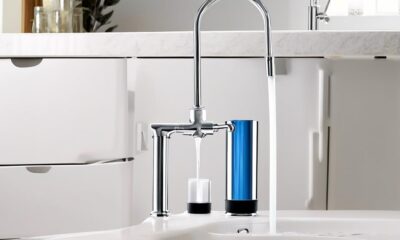Decor
What Makes Interior Architecture Different From Interior Design?
Get ready to discover the nuanced world of interior architecture and how it goes beyond aesthetics to truly transform spaces.
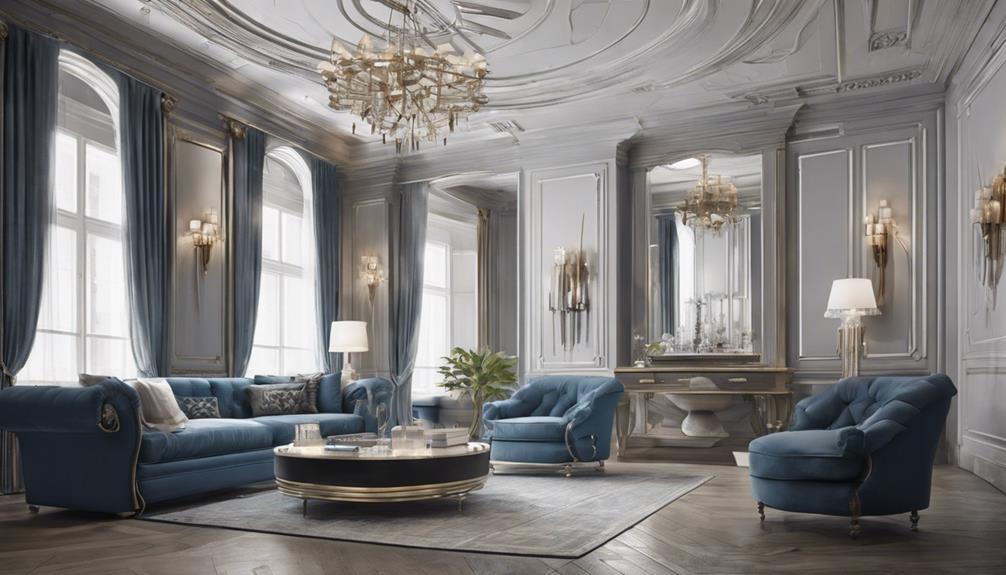
Have you ever wondered how interior architecture truly sets itself apart from interior design?
The distinction goes beyond mere aesthetics, delving into the very bones of a space. By considering the structural integrity, building systems, and the intricate dance between form and function, interior architecture offers a more holistic and deliberate approach to designing interiors.
But what exactly does this entail? Let's explore the nuances that make interior architecture a fascinating field that bridges creativity and technical expertise in shaping the spaces we inhabit.
Key Takeaways
- Interior architecture prioritizes structural functionality over visual aesthetics.
- Collaboration with engineers ensures functional designs in interior architecture.
- Interior architects focus on technical elements like building materials and spatial planning.
- Interior designers enhance existing interiors with a focus on visual appeal and mood.
Key Differences in Design Focus
In comparing interior architecture and interior design, the key differences in design focus are distinctly evident, highlighting the contrasting emphases on structural functionality versus visual aesthetics. Interior architects explore the intricate fusion of architecture and design, centering their attention on the structural elements and building materials that form the backbone of interior spaces. Their primary goal is to create spaces that not only look appealing but also serve a practical purpose, ensuring that the design isn't only visually pleasing but also structurally sound.
On the other hand, interior designers primarily concentrate on the aesthetic appeal of a space, focusing on creating atmospheres that evoke specific moods and emotions. They work with existing interiors, optimizing them for functionality and visual allure, utilizing decorative elements and artistic flair to transform spaces. While interior architects build from the ground up, interior designers reimagine and enhance what already exists, playing with textures, colors, and lighting to craft stunning environments that captivate the senses.
Scope of Interior Architecture
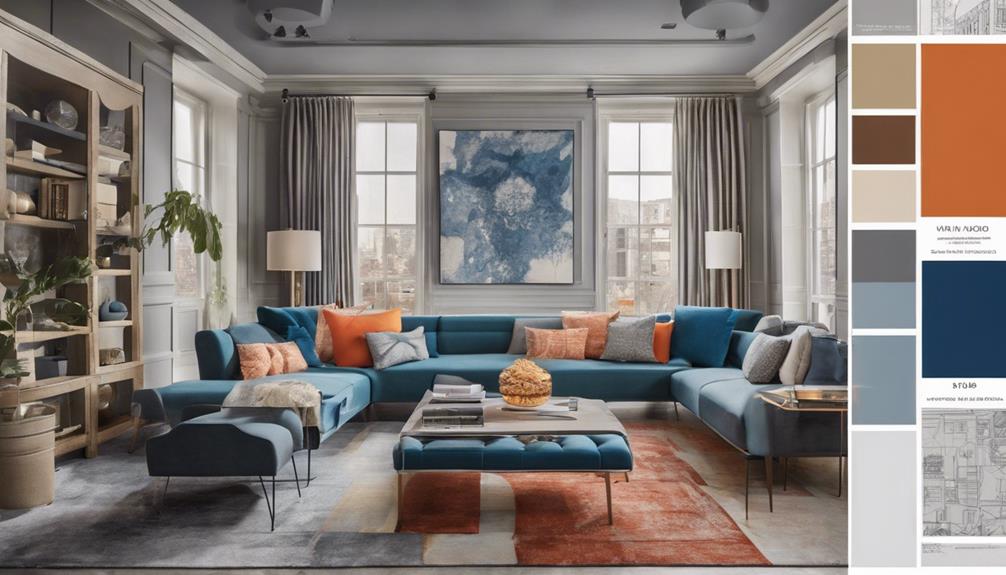
Exploring the domain of interior architecture unveils a meticulous process where functionality, materials, and structural elements converge to redefine existing interior spaces. Unlike interior design, where aesthetics often take precedence, interior architecture focuses on the technical aspects of a space. Interior architects consider factors such as window and door placements, ventilation, heating, and plumbing to make sure that the design isn't only visually appealing but also practical and efficient.
Interior architects collaborate with a range of specialists, including engineers, contractors, and suppliers, throughout the project to make sure that the design meets both aesthetic and functional requirements. They're responsible for creating conceptual designs that prioritize functionality and structure while incorporating interior decoration elements.
While interior designers incorporate interior architecture principles into their work, interior architects typically have a more extensive understanding of building codes, structural integrity, and spatial planning. This difference in scope highlights the degree of technical expertise and attention to detail that interior architects bring to the table.
Technical Vs. Aesthetic Elements
How do interior architecture and interior design differ in their approach to balancing technical and aesthetic elements within a space?
Interior architects and interior designers have distinct focuses when it comes to the technical vs. aesthetic aspects of a project. Interior architecture prioritizes the technical elements, such as ensuring structural integrity, integrating building systems, and adhering to building codes to create functional and safe spaces. Understanding the fundamentals of building science and space planning is critical for interior architects to effectively transform existing structures.
On the other hand, interior designers concentrate more on the aesthetic aspects, like selecting color schemes, furniture, and decor to enhance the visual appeal and atmosphere of a space. While interior designers aim to create visually pleasing environments, interior architects apply these skills to ensure that the space not only looks good but also functions optimally within the existing structure.
Balancing these technical and aesthetic elements is necessary in both interior architecture and interior design to create spaces that are both visually appealing and functional.
Training and Skill Requirements
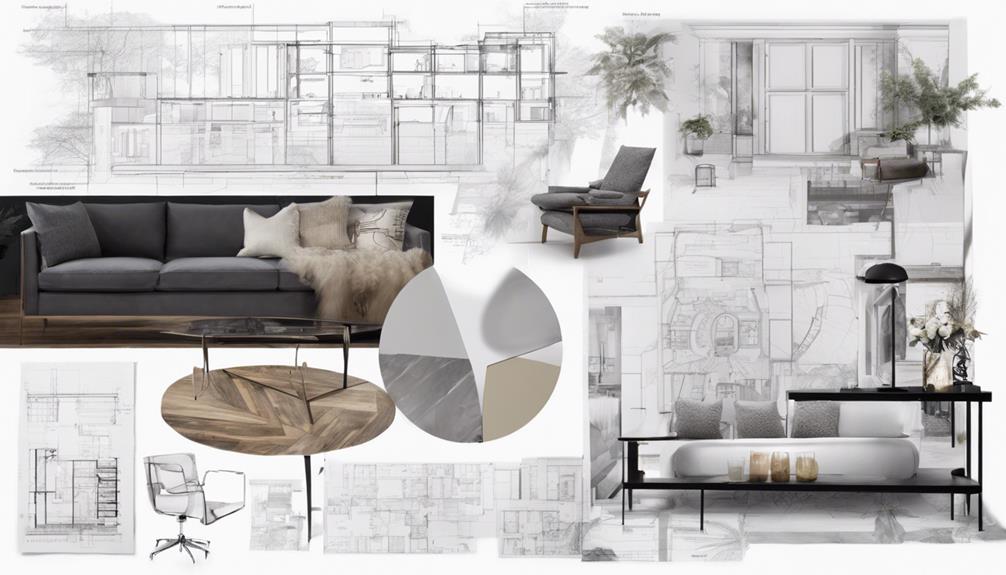
Shifting focus to Training and Skill Requirements, the educational paths for interior architects and interior designers diverge, emphasizing distinct areas of expertise and specialization. Interior architects typically pursue a bachelor's degree in interior architecture or a related field, focusing on structural elements, material construction, and adaptive reuse. Their training explores creating functional spaces that prioritize sustainability and innovation.
On the other hand, interior designers may opt for a bachelor's degree in interior design or a related discipline to develop skills in color theory, furniture selection, and decorative aspects. Both professions share the importance of honing skills in spatial planning, layout design, and client communication. However, interior architects lean towards the technical aspects of design, while interior designers gravitate towards the aesthetic elements.
This contrast in training equips professionals with the necessary tools to excel in their respective fields, whether through creating innovative spatial solutions or crafting visually enchanting environments.
Collaborative Opportunities in Design
In the domain of design collaboration, interior architects seamlessly integrate their expertise in structural elements with interior designers' focus on aesthetics to craft cohesive and functional spaces. This collaboration offers a complete approach to design, considering both the practical and visual aspects of interior spaces. Through working together, interior architects and interior designers can leverage their unique skills to deliver innovative and harmonious interior solutions for various projects.
- Synergy of Skills: Interior architects bring their knowledge of structural elements and material construction, complementing interior designers' expertise in aesthetics and decorative aspects.
- Holistic Design Process: Collaboration allows for a complete design process that considers both the functionality and visual appeal of interior spaces, ensuring a well-rounded outcome.
- Multi-disciplinary Team: Interior architects and interior designers collaborate with engineers, contractors, and suppliers, forming a multi-disciplinary team to guarantee the successful execution of design projects.
This collaborative approach not only enhances the quality of design projects but also fosters creativity and innovation in the field of interior architecture and design.
Frequently Asked Questions
What Is the Difference Between Interior Design and Interior Architecture?
We craft interior spaces that blend form and function seamlessly. We design with purpose, integrating structural elements, materials, and aesthetics. Our work considers every detail, from layout to ventilation, creating spaces that inspire and elevate living experiences.
Can an Interior Architect Do Interior Design?
Yes, we can. An interior architect can definitely do interior design. Our expertise in structural elements, materials, and regulations gives us a unique perspective that enhances the aesthetics and functionality of interior spaces.
Why Is Interior Design Separate From Architecture?
We acknowledge the separation of interior design from architecture due to their distinct focuses. Interior design prioritizes aesthetics and functionality within spaces, while architecture concentrates on the structural aspects of buildings. Each discipline contributes uniquely to holistic design solutions.
What Does an Interior Designer Do Compared to an Architect?
We focus on crafting interior spaces with style and functionality. Interior designers select furniture and colors, while architects prioritize structural integrity. Collaboration guarantees cohesive designs. Architects consider the exterior, while we emphasize indoor aesthetics, blending design and architecture seamlessly.
Conclusion
To sum up, interior architecture explores further into the structural elements and functionality of interior spaces, while interior design focuses more on aesthetics and decorative aspects.
The collaboration between interior architects, engineers, and contractors guarantees a thorough and strategic approach to designing spaces.
By balancing technical expertise with aesthetic considerations, interior architecture offers a unique blend of creativity and functionality, making it an essential component in creating innovative and visually stunning interior environments.
- About the Author
- Latest Posts
Introducing Ron, the home decor aficionado at ByRetreat, whose passion for creating beautiful and inviting spaces is at the heart of his work. With his deep knowledge of home decor and his innate sense of style, Ron brings a wealth of expertise and a keen eye for detail to the ByRetreat team.
Ron’s love for home decor goes beyond aesthetics; he understands that our surroundings play a significant role in our overall well-being and productivity. With this in mind, Ron is dedicated to transforming remote workspaces into havens of comfort, functionality, and beauty.
Decor
The Trend of Dark Blue Shiplap in Design
Uncover the allure of dark blue shiplap in design, a sophisticated trend bringing elegance and modernity to traditional interiors.
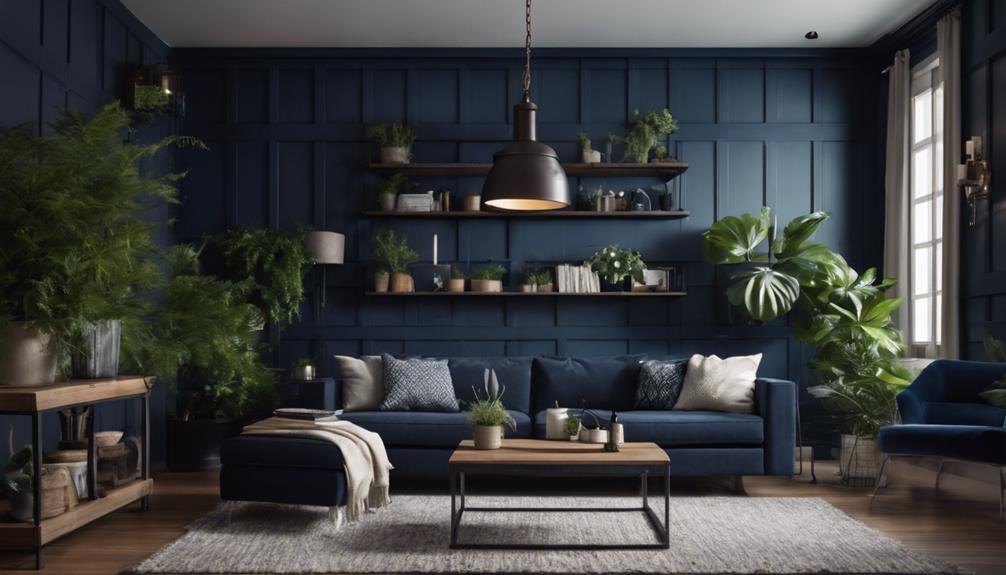
Dark blue shiplap, such as Naval by Sherwin-Williams, is a trendy choice offering a contemporary touch to traditional designs. This deep hue brings elegance and sophistication to interiors, making it a versatile option for accent walls in various rooms. Favored in modern farmhouse settings, it pairs well with gold and olive green accents. Dark blue shiplap creates a calming ambiance in bedrooms and adds a modern twist as an alternative backsplash in kitchens. When paired with metallic accents, it adds depth and drama to spaces. Stay tuned for more insights into this bold and sophisticated design trend.
Key Takeaways
- Dark blue shiplap offers a modern twist on traditional designs.
- Popular for accent walls and chic alternative backsplashes.
- Evokes calm and sophistication in interiors.
- Creates striking focal points with depth and drama.
- Versatile design element for modern farmhouse and contemporary styles.
Dark Blue Shiplap: A Modern Twist
Dark blue shiplap offers a contemporary touch to traditional designs. When painted in a deep hue like Naval by Sherwin-Williams, this rustic material takes on a modern twist, ideal for those seeking a balance between classic and trendy.
The dark blue tone brings a sense of calm and sophistication to interior spaces, making it a versatile choice for accent walls in various rooms. Bedrooms adorned with dark blue shiplap exude coziness and style, creating a serene atmosphere for relaxation. To elevate the design further, incorporating gold accents alongside the shiplap can add a touch of luxury and elegance.
In kitchens, dark blue shiplap serves as a chic alternative backsplash, providing a trendy and modern look that complements a variety of decor styles. Whether aiming for a rustic charm or a more contemporary aesthetic, dark blue shiplap is a popular choice that can transform any space with its unique blend of tradition and innovation.
Bold and Sophisticated Design Trends

Bold and sophisticated design trends are making a significant impact in the world of interior decor.
Dark blue shiplap, particularly in modern farmhouse settings, has emerged as a favored choice among designers and homeowners alike. The deep, rich tones of dark blue shiplap bring a sense of elegance and refinement to any space. Influenced by Sherwin-Williams and Pantone's 2020 colors of the year, Naval and Classic Blue, this trend has gained traction for its ability to create a striking visual contrast.
When paired with accents in gold and olive green, dark blue shiplap can transform a room into a sophisticated oasis.
In bedrooms, this color choice evokes a calming ambiance, ideal for fostering relaxation and tranquility. Additionally, incorporating dark blue shiplap in kitchens offers a contemporary twist, especially as a stylish alternative to traditional tile backsplashes.
By embracing these design trends, spaces can achieve a bold yet refined aesthetic that's both timeless and alluring.
Creating Striking Focal Points
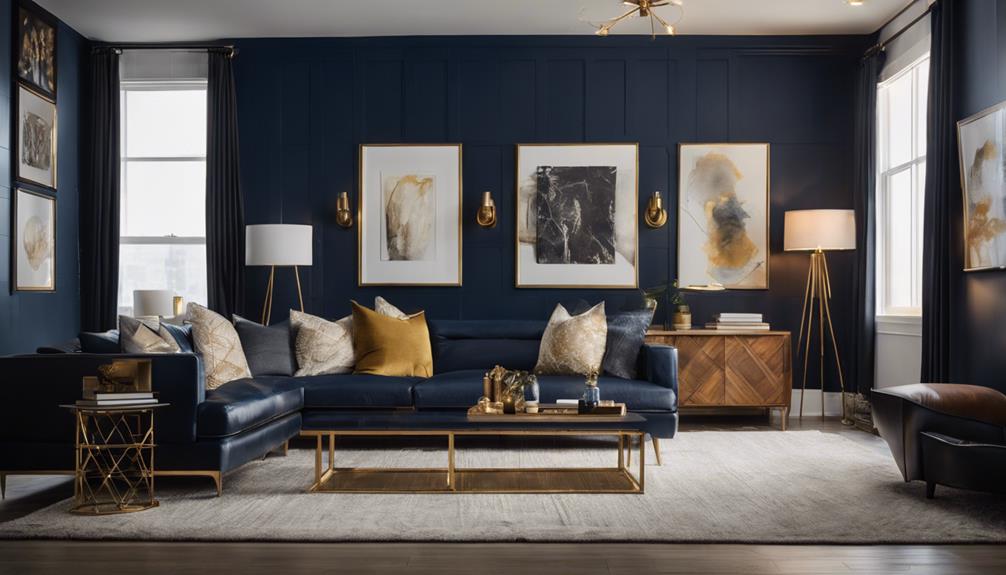
When designing a room, creating striking focal points is essential to draw the eye and make a lasting impression on visitors. Dark blue shiplap, with its ability to add depth and drama to a space, is a popular choice for achieving this effect.
Here are some ways in which incorporating dark blue shiplap can create striking focal points:
- Pairing dark blue shiplap with metallic accents like gold or brass can lend a luxurious look to the room.
- In bedrooms, using dark blue shiplap can evoke a sense of calm and tranquility, perfect for promoting relaxation.
- The contrast of dark blue shiplap against white kitchens can bring a modern and sophisticated feel to the space.
- When used in nursery spaces, dark blue shiplap can help create a peaceful and serene environment for both babies and parents alike, enhancing the overall ambiance of the room.
Elegant Richness in Interiors
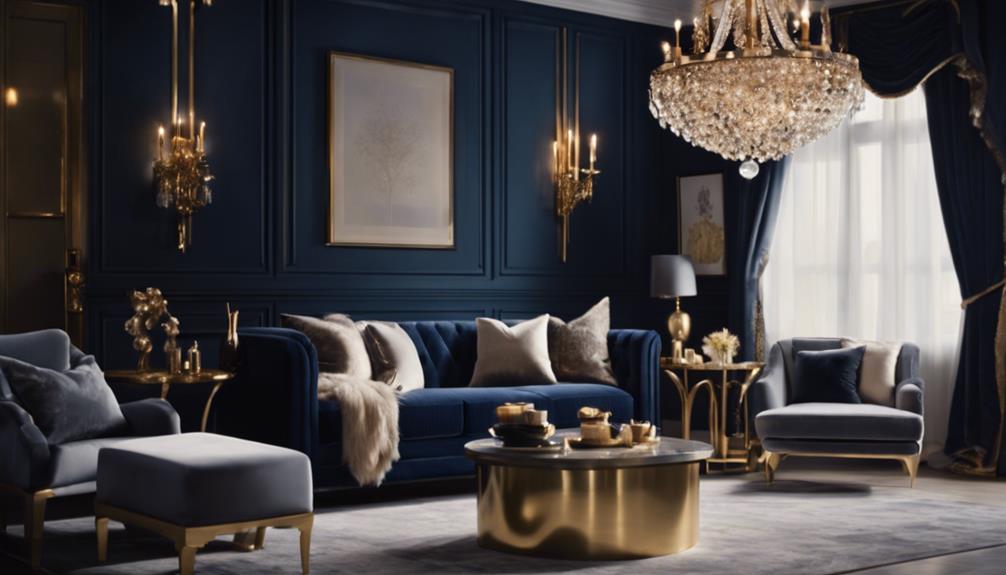
To infuse interiors with an elegant richness, incorporating deep blue shiplap like Naval by Sherwin-Williams can bring a sophisticated and luxurious ambiance to any space.
The deep, dark shade of blue in traditional shiplap adds a rustic yet refined touch, creating a sense of depth and warmth. When paired with gold accents, this color choice elevates the room to a new level of opulence and elegance.
Bedrooms adorned with dark blue shiplap walls offer a serene and calming atmosphere, ideal for relaxation and unwinding after a long day. Introducing metals such as brass and copper alongside the deep blue shiplap enhances the overall sophistication of the space, balancing the traditional feel with a modern touch.
In white kitchens, the contrast between the dark blue shiplap and the pristine white cabinetry creates a striking visual impact, adding character and charm to the design. This combination of dark blue shiplap and various elements presents a timeless and elegant aesthetic for interior spaces.
The Contemporary Appeal of Shiplap

Shiplap's contemporary allure lies in its timeless yet versatile design that seamlessly blends with various interior styles, from modern farmhouse to coastal chic.
Design experts see a shift towards more modern interpretations of shiplap, embracing sleeker forms, innovative wood applications, and unconventional paneling techniques.
Reclaimed wood planking has emerged as a favored alternative, offering a fresh take on traditional shiplap with its distinct textures and vibrant color palettes.
Modern Shiplap Styling
The contemporary allure of modern shiplap styling lies in its sleek forms and incorporation of contemporary elements for a refreshed aesthetic. Designers are exploring exciting ways to modernize shiplap by integrating alternative paneling styles and contemporary wood applications.
Here are some key features of modern shiplap styling:
- Reclaimed Wood Planking: Utilizing reclaimed wood planking offers a popular alternative to traditional shiplap, providing unique textures and colors for a more distinctive look.
- Diversified Color Palette: Moving beyond the classic white and blue hues, designers are experimenting with bolder shades to inject a sense of modernity into shiplap designs.
- Sleek Forms: Modern shiplap designs often feature sleek forms that contribute to a more streamlined and contemporary appearance.
- Contemporary Elements: Incorporating contemporary elements such as minimalist hardware or industrial accents can transform shiplap into a stylish and modern design element.
Versatile Design Element
With its clean lines and classic appeal, shiplap offers a versatile design element that seamlessly fits contemporary aesthetics. The ability of shiplap to provide a modern farmhouse look and evoke a coastal feel has made it a popular choice in interior design.
This timeless feature can be customized with various finishes and colors, including the trending dark blue, allowing it to adapt to different design preferences. The contemporary appeal of shiplap lies in its capacity to add character and texture to any space, creating a visually appealing environment.
From accent walls to ceilings, shiplap can be used creatively to enhance the overall design of a room, offering a dynamic and versatile option for interior decoration. Its adaptability and ability to blend with various styles make shiplap a valuable design element that can bring a touch of sophistication and charm to any living space.
Making a Statement With Color

To make a statement with color, one can strategically utilize the bold and alluring dark blue shiplap design. Dark blue shiplap is a popular choice for creating a moody atmosphere, adding sophistication to interior spaces.
By incorporating navy blue tones influenced by Sherwin-Williams and Pantone's 2020 colors of the year, such as Naval and Classic Blue, one can achieve a modern and stylish look. Adding gold accents to dark blue shiplap can introduce a touch of luxury and elegance, elevating the overall aesthetic of the room.
Pairing dark blue shiplap with white kitchens creates a striking contrast, offering a chic and contemporary feel to the space. Whether used in bedrooms for a calming ambiance or integrated into living areas for a sophisticated touch, dark blue shiplap proves to be a versatile design element that can truly make a statement with its rich color palette and unique texture.
Frequently Asked Questions
Is Navy Blue Still on Trend?
Yes, navy blue remains a prevalent choice in design. Influenced by Sherwin-Williams and Pantone's 2020 color picks, dark blue shiplap continues to be a go-to for creating a refined and tranquil ambiance.
Its versatility allows for dramatic yet sophisticated applications in various spaces. Pairing navy blue shiplap with complementary hues like gold and olive green can enhance the overall aesthetic.
Incorporating this trend in home accents modernizes traditional settings, adding a touch of contemporary flair.
What Is the New Trend Instead of Shiplap?
While shiplap has had its moment in the spotlight, designers are now gravitating towards board and batten walls for a sleek, modern aesthetic.
Reclaimed wood planking is also gaining traction as a distinctive alternative to traditional shiplap. Additionally, contemporary wood applications are providing a fresh take on the classic style.
Experimentation with paneling styles such as reeded or fluted panels is on the rise, offering a diverse range of options beyond the confines of shiplap.
Is Shiplap Still in Style in 2024?
Shiplap remains a popular choice in 2024 due to its timeless appeal and versatility. This classic design element continues to be favored by homeowners and designers alike for its ability to add texture and character to a space.
Its enduring popularity is evident in various rooms, such as bedrooms, kitchens, and bathrooms. The trend of dark blue shiplap is also emerging as a modern and sophisticated option, offering a calming and elegant atmosphere.
Is Shiplap Timeless or Trendy?
Shiplap's enduring popularity prompts a debate: is it timeless or trendy? Our analysis reveals shiplap's adaptable nature stands the test of time, making it a classic choice for design enthusiasts.
While trends come and go, shiplap's versatility allows it to seamlessly blend into various aesthetics. Whether embracing a traditional or modern style, shiplap remains a reliable design element that transcends fleeting trends.
Its lasting appeal solidifies shiplap's reputation as a timeless design staple.
Conclusion
To sum up, the trend of dark blue shiplap in design offers a modern and sophisticated twist to interiors. Its ability to create striking focal points and add an elegant richness to spaces makes it a popular choice among homeowners and designers alike.
As we continue to see the contemporary appeal of shiplap grow, incorporating this bold color choice can truly make a statement in any room, elevating the overall aesthetic and style.
- About the Author
- Latest Posts
Introducing Ron, the home decor aficionado at ByRetreat, whose passion for creating beautiful and inviting spaces is at the heart of his work. With his deep knowledge of home decor and his innate sense of style, Ron brings a wealth of expertise and a keen eye for detail to the ByRetreat team.
Ron’s love for home decor goes beyond aesthetics; he understands that our surroundings play a significant role in our overall well-being and productivity. With this in mind, Ron is dedicated to transforming remote workspaces into havens of comfort, functionality, and beauty.
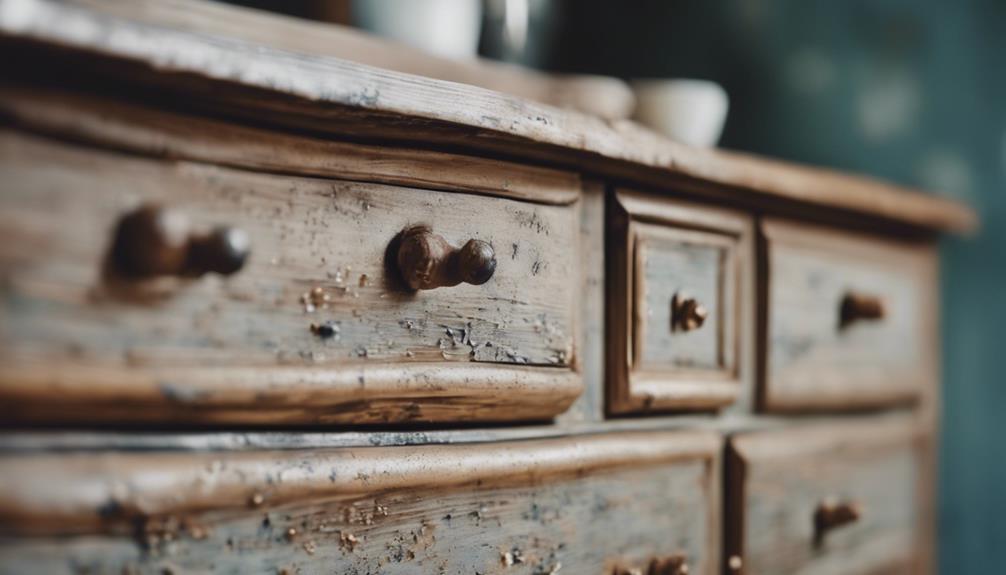
Repurposing an old dresser demands precision and care. Remove drawers with caution, noting mechanisms and hardware. Craft a bench seat and back thoughtfully, using quality materials. Sand meticulously for a flawless finish. Opt for high-quality paint and stain, applying thin, even coats. Style your bench creatively for functionality. Guarantee accurate measurements when cutting to size. Select primers and finishes wisely for long-lasting results. If you seek to access the complete step-by-step guide, further insights await.
Key Takeaways
- Use quality tools for precision cuts and smoother finishes.
- Safely remove drawers by following specific instructions.
- Measure accurately and shape wood pieces for the bench.
- Sand dresser thoroughly for a professional paint finish.
- Apply primer and finishing coats for durability and aesthetic appeal.
Tools and Materials Needed
To begin repurposing an old dresser, we'll need a set of essential tools and materials for the transformation process. Key tools include a jigsaw, reciprocating saw, hammer, sander, skill saw, or table saw, finish nailer, and Rapid Fuse. These tools are vital for dismantling the dresser, creating new components, sanding, painting, and finishing the repurposed piece.
Additionally, materials such as bead board for support or replacing wood may be required during the transformation. Proper utilization of these tools guarantees a successful and professional-looking outcome when repurposing the old dresser into a new functional item.
Investing in quality tools and materials will make the project more manageable and efficient, resulting in a beautifully transformed piece of furniture. Remember, having the right tools at your disposal is the first step towards a successful dresser repurposing project.
Removing Dresser Drawers
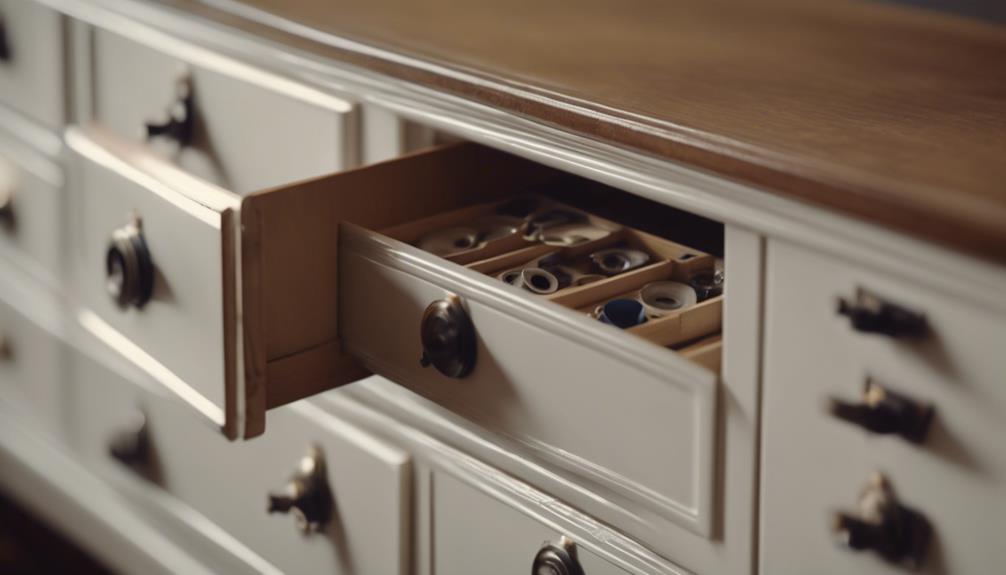
When removing dresser drawers, one must first clear out any items inside and make sure there are no obstructions blocking the way.
Locating the drawer stop mechanism is important, as it varies in form and design from dresser to dresser. Following the specific instructions for your particular model is essential to safely release the drawer stops and extract the drawer without causing damage.
Drawer Removal Techniques
We start by fully extending each drawer until it reaches its stopping point.
When removing dresser drawers, it's important to look for release mechanisms such as tabs or levers located on the drawer slides. These mechanisms allow you to disconnect the drawers from the dresser easily.
Keep an eye out for hidden screws or clips that may be securing the drawers in place; these will need to be removed before you can successfully take out the drawer.
Remember to proceed with caution, especially with heavy or stuck drawers, to prevent any injuries or damage to the dresser.
It's advisable to keep track of all hardware and screws as you disassemble the drawers to simplify the reassembly process later on.
Tools Needed for Removal
For removing dresser drawers, having the right tools available is essential for a smooth and efficient process. Utilizing a jigsaw and reciprocating saw can greatly facilitate the removal of drawers, especially for cutting through stubborn components. These tools provide the precision and power needed to disassemble the drawers effectively.
In some cases, a hammer might be necessary to aid in separating tightly joined parts. Additionally, consider using a sander to smooth out any rough edges left behind after the removal process, ensuring a clean finish.
For those seeking even more accuracy in cutting, a skill saw or table saw could be advantageous. When it comes to reassembly or repairs post-removal, having a finish nailer and Rapid Fuse adhesive on hand can be beneficial for securing components back in place. By having these tools ready, the task of removing dresser drawers can be accomplished with greater ease and efficiency.
Safety Precautions During Removal
Having the appropriate tools for removing dresser drawers is vital to guarantee a safe and efficient process. When working with an old dresser, it's crucial to take safety precautions to prevent accidents.
To begin with, make sure the drawers are empty before attempting to remove them, as contents inside can shift and cause instability. Use caution when pulling out the drawers to avoid injuries from falling or sliding drawers. Maintain a firm grip on the handles or sides of the drawers to have better control over the removal process.
Before handling the drawers, inspect them for any sharp edges or protruding nails that could potentially harm you during removal. Additionally, work in a well-lit area to clearly see and navigate the removal process safely.
Creating Bench Seat and Back

To craft the bench seat and back for your repurposed dresser, accurately measure and cut wood pieces based on the dresser's dimensions. When creating the bench seat, it's important to ensure stability and comfort.
Here's how to proceed:
- Use a jigsaw or reciprocating saw to shape the wood pieces for the bench seat according to your desired design.
- Add bead board or additional wood pieces for back support, ensuring a sturdy and reliable structure.
- Always double-check the measurements to guarantee a perfect fit within the dresser frame.
Sanding Techniques
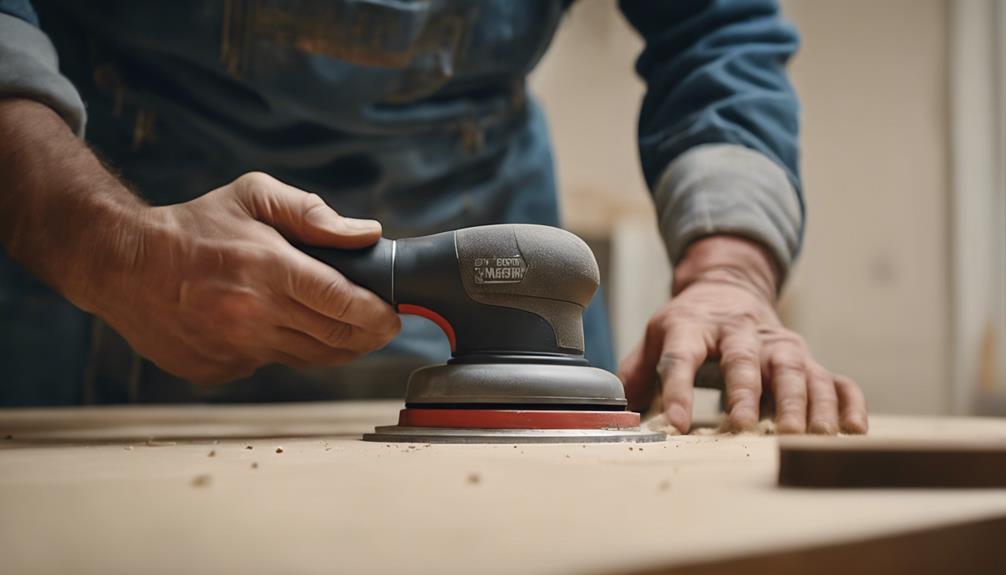
Sanding an old dresser is an essential step in the refinishing process to achieve a smooth and flawless surface. Proper sanding helps remove old paint, stains, and imperfections, revitalizing the look of the furniture. To effectively sand an old dresser, start with coarse sandpaper to strip away the existing finish. Progress to finer grits gradually to ensure a polished result. Using a sanding block or an electric sander can make the job more efficient and provide a consistent finish across the entire piece. Pay close attention to details such as corners, edges, and intricate designs to achieve a professional outcome. Thorough sanding prepares the dresser for painting, staining, or sealing, ensuring a durable and aesthetically pleasing final product.
| Sanding Tips | Description |
|---|---|
| Start Coarse | Strip away old finish effectively. |
| Progress to Finer | Achieve a smooth and polished surface. |
| Focus on Details | Pay attention to corners, edges, and intricate designs for a professional finish. |
Painting and Staining Tips
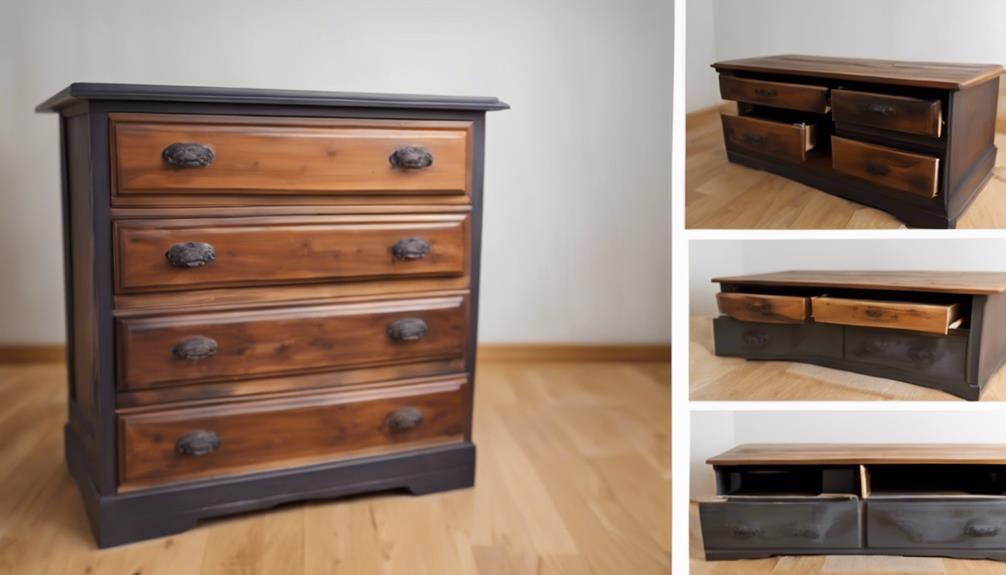
For achieving a professional finish, it's important to carefully select high-quality paint and stain specifically formulated for furniture.
When starting on a DIY project like repurposing an old dresser, following these painting and staining tips can help you achieve a flawless transformation:
- Choose the Right Products: Opt for paint and stain that are designed for use on furniture to guarantee durability and longevity of the finish.
- Apply Thin Coats: To avoid drips and achieve a smooth finish, apply multiple thin coats of paint or stain, allowing each layer to dry completely before proceeding.
- Consider Priming: Using a primer before painting can enhance color coverage and adhesion, particularly beneficial for dark or glossy surfaces.
Following these steps in your DIY project won't only result in a beautifully refurbished dresser but also make sure that your hard work lasts for years to come.
Styling the Finished Bench

We can enhance the visual appeal and functionality of the finished bench by creatively styling it in various spaces within our home. The versatility of the repurposed dresser allows us to incorporate it into our decor in multiple ways. Here are some ideas for bench styling and functional storage:
| Styling Ideas | Functionality |
|---|---|
| Use as shoe storage in a mudroom | Provides organized and stylish storage for footwear |
| Place in the front entryway | Combines seating and storage space for a practical and aesthetic entry |
| Create a cozy reading nook in a little girl's room | Adds charm and functionality for a comfortable space |
| Display and store treasures on the bench | Adds a decorative element to any room while providing functional storage |
Cutting Down for Bench Size
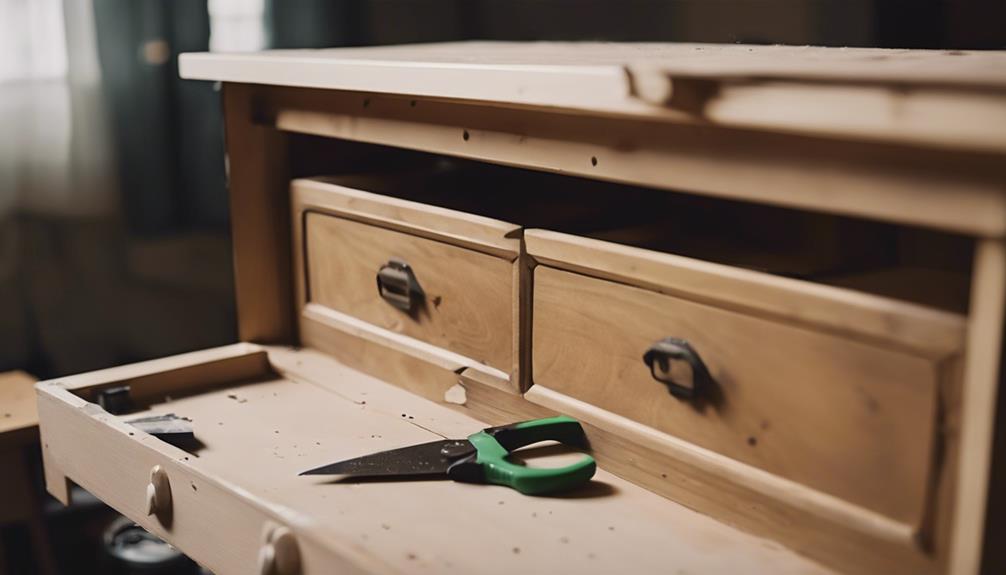
To achieve the desired bench size, we need to accurately measure and mark the dresser before making the necessary cuts. Here are some key steps to follow:
- Measure Twice: Before cutting down the dresser to the bench size, double-check all measurements to guarantee accuracy and avoid mistakes.
- Use the Right Tool: Opt for a jigsaw or reciprocating saw to make the cuts, guaranteeing precision and ease of maneuverability during the process.
- Maintain Evenness: When cutting the dresser to transform it into a bench, make sure that the cuts are straight and even for a polished and professional finish.
Priming and Finishing Coats
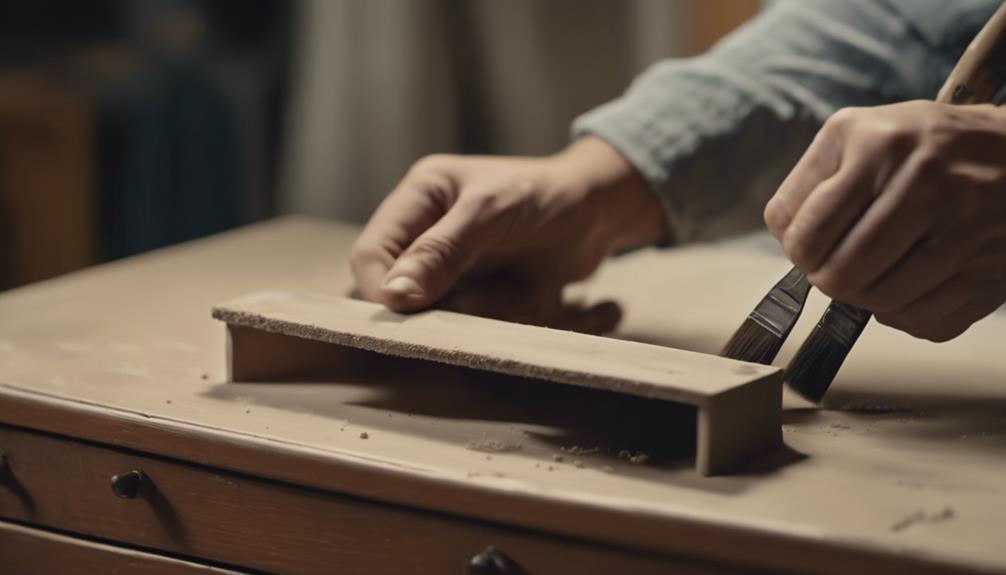
Applying a primer coat is essential to guarantee that the paint adheres properly to the dresser's surface, creating a solid foundation for the finishing coats. Make sure to select a high-quality primer that matches the material of the dresser, such as wood or laminate, for best results.
Additionally, finishing coats not only safeguard the dresser from daily wear and tear but also provide a lasting and resilient finish, enhancing the overall appearance of the repurposed piece.
Surface Preparation
Proper surface preparation for repurposing an old dresser involves sanding, priming, and applying finishing coats to guarantee a professional and durable finish.
Here are essential steps for surface preparation:
- Sanding: Begin by thoroughly sanding the dresser to remove any existing paint or finishes. This process creates a smooth surface for the new coats of paint or stain to adhere to effectively.
- Priming: After sanding, apply a layer of primer to the dresser. Priming helps the new finish adhere better to the surface and provides a more even base for the color application, ensuring a consistent and long-lasting result.
- Finishing Coats: Finally, applying finishing coats like varnish or sealant is vital. These coats not only enhance the aesthetic appeal of the dresser but also protect it from wear and tear, increasing the longevity of the repurposed piece.
Paint Application
For optimal results in painting an old dresser, we recommend starting with a high-quality primer to guarantee paint adhesion and durability. Priming is vital when refurbishing furniture pieces to create a smooth and long-lasting finish. Choose a primer specifically designed for use on furniture to ensure proper adhesion and prevent the paint from chipping or peeling over time.
When applying paint to the dresser, it's essential to use multiple thin coats rather than one thick layer. This approach allows for better coverage and a smoother finish. Confirm that each coat is fully dry before applying the next to avoid any unevenness or bubbling in the paint.
Consider using a paint sprayer for a more even and professional-looking application. However, if a paint sprayer isn't available, a high-quality paint brush or roller can also achieve a consistent and smooth finish on the dresser.
To enhance the longevity of the paint and protect the surface, finish the dresser with a clear protective coat. This final step will seal the paint and provide an extra layer of durability against daily wear and tear.
Frequently Asked Questions
How to Turn an Old Dresser Into Something New?
When considering how to turn an old dresser into something new, it's crucial to evaluate its condition and style. Sanding, painting, and adding new hardware can revitalize the dresser.
Repurposing the existing structure creatively guides the transformation process. This approach breathes new life into the furniture and allows for a personalized touch in your living space.
Careful planning and attention to detail are key in achieving a successful and unique outcome.
How Do You Make an Old Wooden Dresser Look Modern?
To make an old wooden dresser look modern, we suggest painting it with a trendy color like navy blue or blush pink. Swapping out the old hardware for sleek, contemporary drawer pulls can instantly update its look.
Adding geometric or abstract designs with paint or wallpaper can give it a fresh, modern vibe. Incorporating metallic accents like gold or silver spray paint can also bring a touch of glamour to the dresser.
Consider embracing a minimalist or Scandinavian design style for a clean, modern aesthetic.
How to Refurbish a Wooden Dresser?
When refurbishing a wooden dresser, begin by sanding down the surface to remove old paint and create a smooth base.
Address any structural issues like loose joints before applying a high-quality wood stain or paint for a fresh appearance.
Consider updating the hardware for a modern touch.
Finish by applying a clear protective coat to prolong the dresser's longevity.
Following these steps will guarantee a successful refurbishment of a wooden dresser.
How to Repurpose Old Drawers?
When looking to repurpose old drawers, we've found various creative solutions. Convert them into storage bins for small items like jewelry, craft supplies, or office supplies.
Alternatively, consider transforming them into wall shelves by adding brackets, creating a unique display option.
For a touch of greenery, repurpose drawers as planters, offering an eco-friendly gardening alternative.
Don't forget about your furry friends – repurpose drawers into pet beds by adding cushions.
The possibilities are endless!
Conclusion
To sum up, repurposing an old dresser into a beautiful bench is a rewarding DIY project that can breathe new life into your space.
Just like a caterpillar transforms into a butterfly, your dresser can undergo a stunning metamorphosis with a little creativity and effort.
So grab your tools and get started on your own transformation journey today!
- About the Author
- Latest Posts
Introducing Ron, the home decor aficionado at ByRetreat, whose passion for creating beautiful and inviting spaces is at the heart of his work. With his deep knowledge of home decor and his innate sense of style, Ron brings a wealth of expertise and a keen eye for detail to the ByRetreat team.
Ron’s love for home decor goes beyond aesthetics; he understands that our surroundings play a significant role in our overall well-being and productivity. With this in mind, Ron is dedicated to transforming remote workspaces into havens of comfort, functionality, and beauty.
Mardi Gras Decoration
How Do You Make a Floating Paper Lantern?
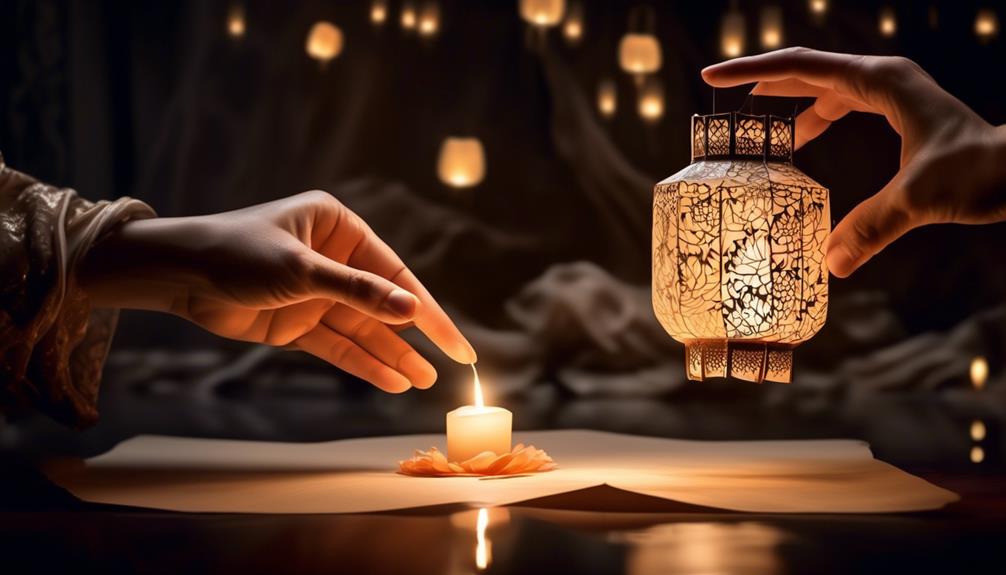
Have you ever been to a festival where you witnessed the stunning sight of floating paper lanterns lighting up the night sky?
Have you ever wondered how they're made and how you can create one yourself?
Making a floating paper lantern is a fascinating and rewarding experience, but it requires attention to detail and a few key techniques.
If you're interested in learning the art of crafting these mesmerizing creations, we have just the guide for you.
Key Takeaways
- Lightweight and flame-resistant paper, such as rice paper or tissue paper, is essential for making a floating paper lantern.
- Incorporate meaningful symbols or motifs in the design of the lantern to add a personal touch.
- Use adhesive and small fasteners to attach the frame, choosing lightweight yet sturdy materials.
- Enhance the lantern's visual appeal by adding decorative elements such as glitter, ribbons, markers, and adhesive gems.
Choosing the Right Paper
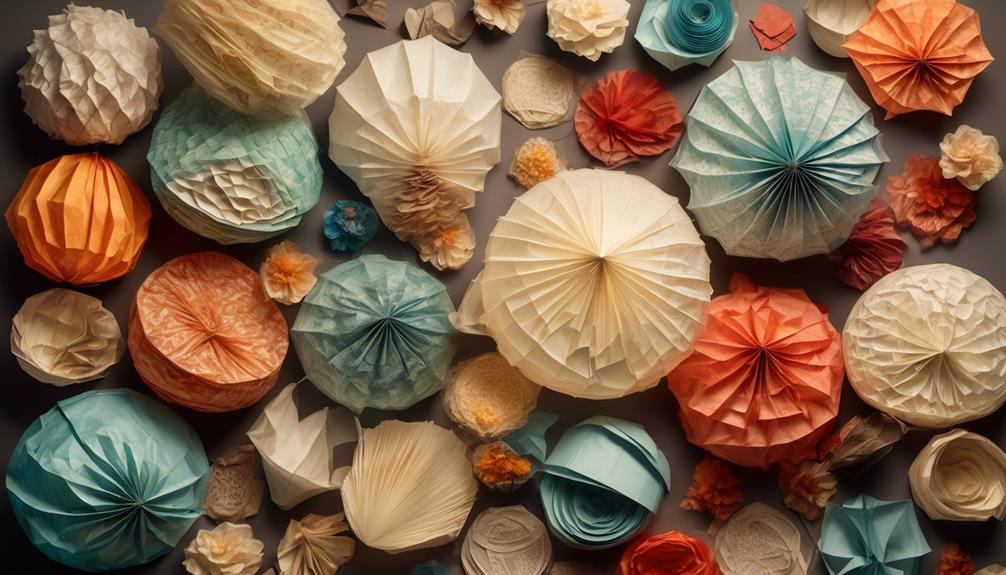
When making a floating paper lantern, it's vital to select a paper that's both lightweight and flame-resistant. The paper quality is crucial for the durability and safety of the lantern. We found that rice paper or tissue paper works best due to its lightweight nature and flame-resistant properties. These papers are sturdy enough to hold their shape when the lantern is assembled and provide a beautiful glow when the candle is lit inside.
As for color options and aesthetics, there are numerous choices to consider. The color of the paper can significantly affect the ambiance and visual appeal of the lantern. From vibrant and bold hues to soft pastel shades, the color options are endless. Some may prefer a traditional look with white or off-white paper, while others may opt for a more colorful and eye-catching lantern.
Additionally, consider the translucency of the paper as it can influence the way the light shines through, creating a mesmerizing effect.
Designing Your Lantern
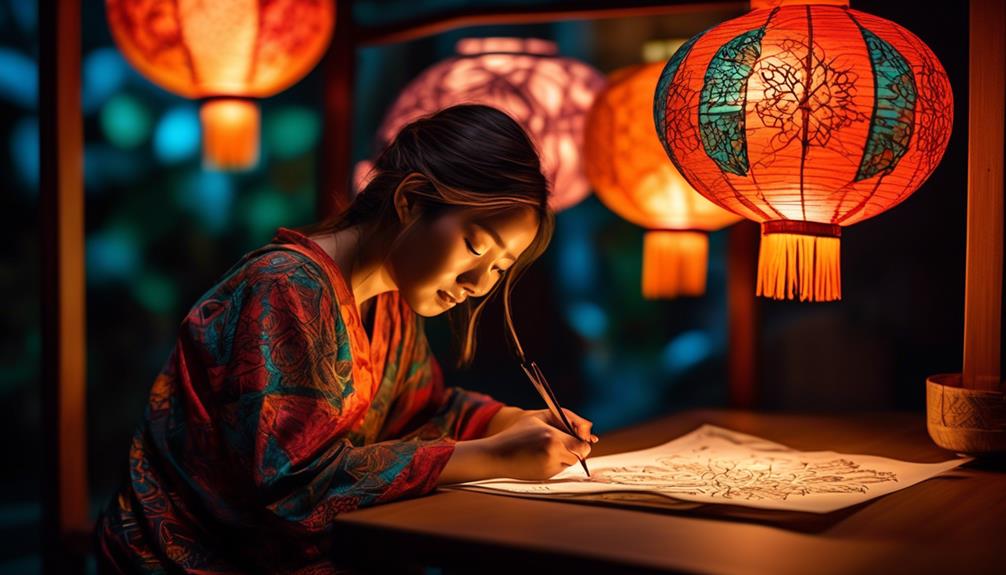
To design your lantern, consider incorporating meaningful symbols or personal motifs to enhance its visual impact and emotional significance. Lantern customization allows for a personalized touch, making it a unique reflection of individuality. Here are some tips to guide you through the designing process:
- Reflect on Meaning: Choose symbols or motifs that hold personal significance, such as a favorite quote, a meaningful date, or a representation of a cherished memory. Infusing your lantern with personal meaning adds depth and emotional resonance.
- Embrace Creativity: Let your imagination run wild and explore various design possibilities. Incorporate colors, patterns, and imagery that resonate with your personal style and aesthetic preferences.
- Consider Practicality: While focusing on creativity, ensure that your design allows for the practical aspects of constructing a floating paper lantern. Consider the placement of symbols and motifs to ensure they don't interfere with the structural integrity of the lantern.
- Test and Refine: Before finalizing your design, consider creating a prototype to test its visual impact and functionality. This allows for adjustments and refinements to ensure that your lantern reflects your vision effectively.
Designing your own lantern is a deeply personal and rewarding process, allowing you to infuse a simple paper structure with your unique personality and creativity.
Attaching the Frame
Let's start by discussing the technique for attaching the frame to the paper lantern.
We'll also cover the materials needed for constructing a sturdy and reliable frame.
Additionally, we'll explore effective methods for securing the frame in place to ensure the stability of the lantern.
Frame Attachment Technique
We securely fasten the frame to the paper lantern using a combination of adhesive and small, discreet fasteners. This ensures that the frame remains securely in place, providing stability and support for the lantern.
Here are some key techniques we use for attaching the frame:
- Adhesive Application: We carefully apply a strong, weather-resistant adhesive along the edges of the frame to create a firm bond with the paper lantern.
- Strategic Fastener Placement: We strategically place small fasteners at key points on the frame to reinforce its attachment to the lantern without compromising its appearance.
- Even Distribution: We ensure an even distribution of adhesive and fasteners around the frame to maintain its structural integrity.
- Final Inspection: We meticulously inspect the attachment points to guarantee that the frame is securely and evenly attached to the paper lantern.
Materials for Frame
After securely fastening the frame to the paper lantern using a combination of adhesive and small, discreet fasteners, the next crucial step is to select the appropriate materials for ensuring a durable and reliable attachment. When considering frame construction, it's essential to choose materials that are lightweight yet sturdy. We recommend using bamboo or lightweight wooden dowels for the frame, as they provide the necessary support without adding excessive weight to the lantern. Additionally, supportive materials such as strong adhesive tapes, nylon threads, or small zip ties can be used to reinforce the frame's attachment to the paper. Here's a helpful table outlining the suggested materials for frame construction and reinforcement:
| Frame Construction | Supportive Materials |
|---|---|
| Bamboo | Strong adhesive tapes |
| Lightweight dowels | Nylon threads |
| Small zip ties |
Securing Frame in Place
To secure the frame in place, carefully align the attachment points with the designated areas on the paper lantern. Ensuring frame stability is crucial for the lantern's overall integrity. Here are some anchoring techniques to help secure the frame effectively:
- Twine or String: Use strong twine or string to tie the frame securely to the designated attachment points on the lantern.
- Adhesive Tape: Apply strong adhesive tape to firmly fix the frame in place, ensuring it remains stable.
- Clips or Clamps: Utilize clips or clamps to secure the frame tightly to the designated areas, providing additional stability.
- Staples: For a more permanent attachment, carefully use staples to secure the frame in place, ensuring it withstands external forces.
These techniques will help maintain the stability of the frame, ensuring the paper lantern is securely assembled for floating.
Adding Decorative Elements

Let's talk about the fun part – adding decorative elements to our floating paper lantern!
We'll cover the materials you can use for decoration, different techniques for embellishing your lantern, and how to make color and texture choices that will make your lantern stand out.
It's time to get creative and make our lanterns truly unique!
Materials for Decoration
We can enhance the beauty of the floating paper lantern by incorporating decorative elements such as glitter, ribbons, and colorful markers. Here are some materials for decoration to make your paper lantern truly stand out:
- Glitter: Add a touch of sparkle by using glitter glue or loose glitter to create dazzling patterns or accents on the lantern.
- Ribbons: Attach colorful ribbons to the bottom of the lantern to create a flowing and elegant effect when the lantern is floating on the water.
- Colorful Markers: Use vibrant markers to draw intricate designs, patterns, or meaningful messages on the lantern to personalize it.
- Adhesive Gems: Consider using adhesive gems to add a touch of elegance and glamour to your paper lantern.
These materials offer endless possibilities for creativity and personalization, allowing you to make a truly unique and beautiful floating paper lantern.
Techniques for Embellishment
Enhancing the aesthetic appeal of the floating paper lantern can be achieved through various techniques for embellishment.
When it comes to embellishing your paper lantern, the possibilities are endless.
One creative idea is to use intricate paper cutting techniques to add delicate designs to the lantern. This can be done by carefully cutting out patterns or shapes from colored paper and then adhering them to the surface of the lantern.
Another popular embellishment technique is the use of decorative elements such as glitter, sequins, or beads to add a touch of sparkle and glamour to the lantern.
Additionally, painting the lantern with vibrant colors or using calligraphy to inscribe meaningful phrases can also elevate its visual appeal.
These embellishment techniques allow for personalization and creativity, making each floating paper lantern a unique and beautiful creation.
Color and Texture Choices
When considering color and texture choices for adding decorative elements to your floating paper lantern, it's important to select materials that complement the overall design and ambiance you wish to create. Here are some key considerations:
- Color Choices: Opt for colors that align with the theme of your event or the mood you want to convey. Bright, vibrant colors can create a festive atmosphere, while pastel shades may evoke a sense of tranquility.
- Paper Texture: Choose paper with a delicate texture to create an elegant and refined look. Alternatively, textured paper can add depth and visual interest to your lantern.
- Contrasting Elements: Consider incorporating contrasting colors or textures to make certain decorative elements stand out and create visual appeal.
- Weather Resistance: If you plan to use the lantern outdoors, ensure that the colors and textures are resistant to weather conditions to maintain their beauty.
Assembling the Lantern
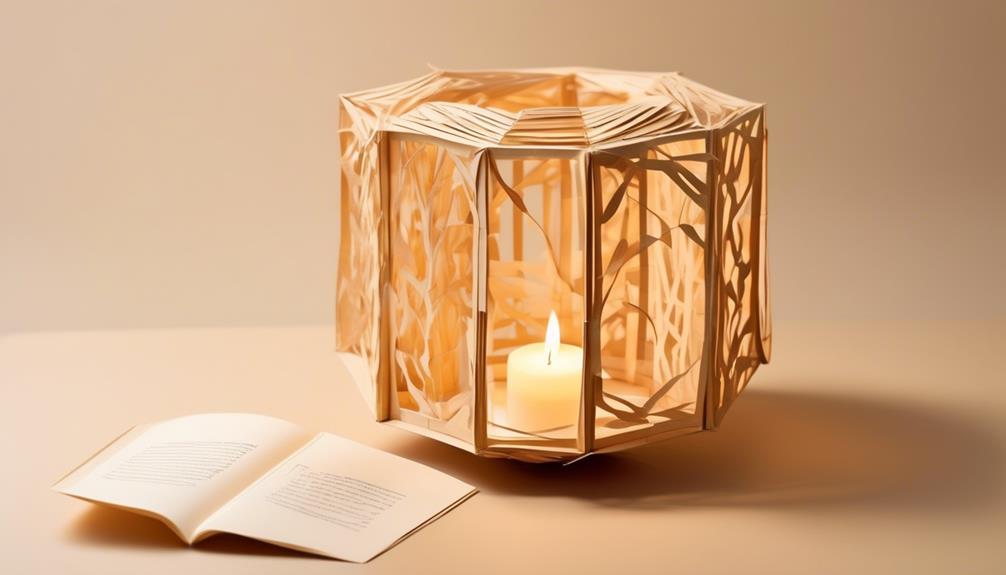
Using a clear adhesive, attach the edges of the paper lantern together to form a cylindrical shape. This step is crucial for ensuring that the lantern holds its shape and provides a sturdy base for the rest of the assembly process. Once the cylindrical shape is formed, gently secure the bottom of the lantern by affixing a circular piece of sturdy paper or cardboard. This will help to stabilize the lantern and provide a surface for the lantern lighting.
In terms of safety measures, it's important to use flameless LED candles or other battery-operated light sources for illuminating the lantern. Avoid using open flames, as they can pose a fire hazard, especially when the lantern is airborne. Additionally, when assembling the lantern, make sure to work in a well-ventilated area and keep any flammable materials away from the assembly space.
Assembling the lantern is an important part of the process, and taking the time to do it carefully will ensure that your floating paper lantern is both beautiful and safe for use.
Preparing the Fuel Source

With the lantern assembled and ready, the next step involves preparing the fuel source for the paper lantern. Ensuring fuel safety is crucial to avoid accidents and enjoy a worry-free experience. Here's how we prepare the fuel source:
- Choose the right fuel: Opt for a clean-burning, liquid fuel that's specifically designed for lanterns. Avoid using flammable substances or fuels that produce excessive smoke.
- Fill the reservoir carefully: Use a funnel to pour the fuel into the lantern's reservoir. Avoid overfilling to prevent spills and maintain flame control.
- Check for leaks: Before igniting the lantern, carefully inspect for any fuel leaks around the reservoir or wick. Address any leaks before proceeding.
- Ignite the lantern safely: Use a long-reach lighter or a fireplace match to ignite the lantern. Maintain flame control by adjusting the wick to achieve the desired brightness.
Igniting the Lantern
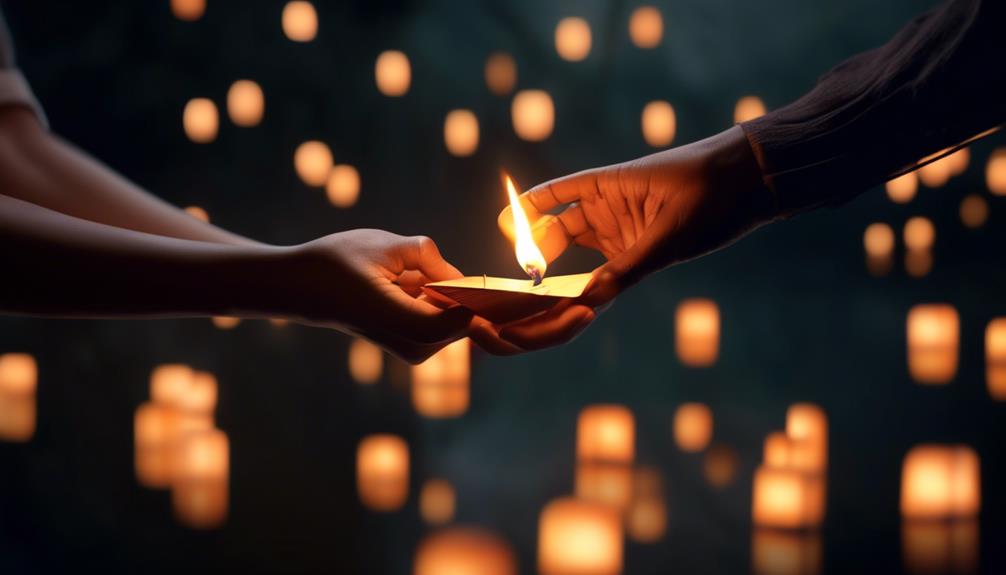
Let's get the lantern glowing by safely igniting the fuel source using a long-reach lighter or a fireplace match. Now that the lantern is prepped and the fuel source is ready, it's time to light it up. Before we delve into the process, it's crucial to emphasize fire safety. Always have a fire extinguisher or bucket of water nearby, and ensure the lantern is lit in an open, outdoor area away from any flammable materials. It's also important to be mindful of cultural significance when igniting the lantern. For many, this act holds deep cultural and spiritual importance, so approach it with reverence and respect.
Here's a simple guide to safely ignite the lantern:
| Steps | Instructions | Tips |
|---|---|---|
| Step 1 | Hold the lantern securely and upright. | Ensure the lantern is stable and upright. |
| Step 2 | Use a long-reach lighter to ignite the fuel. | Avoid leaning over the lantern while lighting. |
| Step 3 | Wait for the lantern to heat up and take flight. | Observe the lantern as it begins to rise. |
| Step 4 | Release the lantern once it's fully lit. | Enjoy the mesmerizing sight as it ascends. |
Launching Your Creation

Now that the lantern is aglow, it's time to release it into the night sky, creating a breathtaking and symbolic display. Before launching your creation, consider these important aspects:
- Sky Lantern Release: Find a spacious, open area away from buildings, trees, and dry vegetation. Ensure that there are no overhead obstructions or windy conditions. The ideal setting is a calm, clear night with minimal wind, allowing your lantern to gracefully ascend into the sky.
- Cultural Significance: Understand the cultural and spiritual significance of releasing sky lanterns. This act is often considered a symbol of good luck, hope, and positive intentions. Take a moment to reflect on the symbolism before releasing your lantern.
- Environmentally Friendly Alternatives: Opt for lanterns made from biodegradable materials, such as rice paper and bamboo, to minimize environmental impact. Avoid using metallic or plastic components that could harm the environment.
- Biodegradable Materials: After the lantern has completed its mesmerizing journey, ensure that any remnants are collected and disposed of responsibly. This includes any biodegradable components, as part of a commitment to environmental stewardship.
As we release our lanterns into the night sky, let's do so with mindfulness and respect for the environment and the cultural significance of this beautiful tradition.
Safety Precautions and Tips
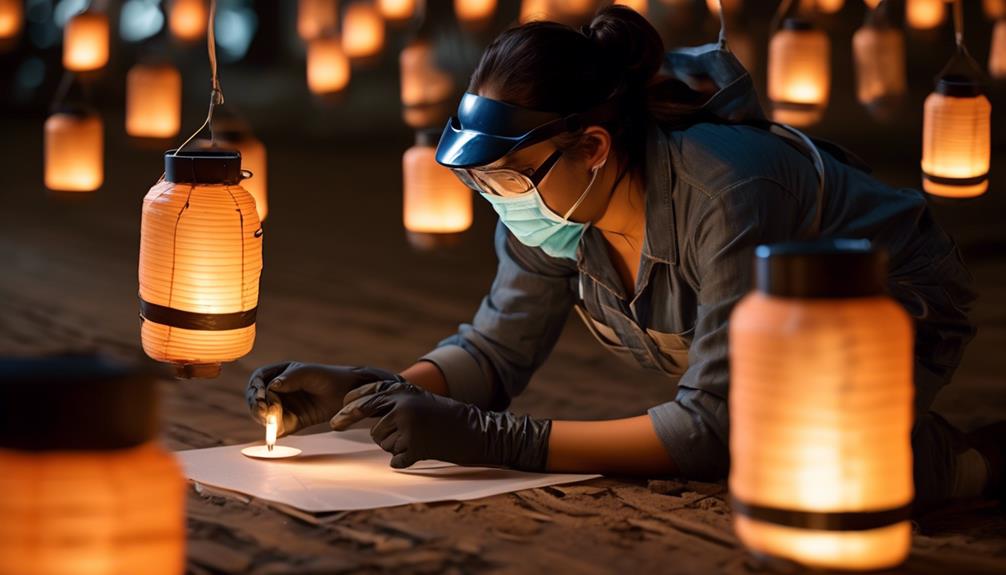
Prior to launching the floating paper lantern, it is crucial to observe safety precautions and consider helpful tips to ensure a smooth and secure experience. When dealing with fire safety, it's important to keep a fire extinguisher or a bucket of water nearby in case of emergencies. Additionally, choose a launch site that is clear of trees, buildings, or any other flammable objects. Wind resistance is another important factor to consider. Always check the weather forecast and avoid launching the lantern in strong winds, as it can lead to uncontrollable flight paths.
To ensure a safe and enjoyable experience, here are some essential safety precautions and tips to keep in mind:
| Safety Precautions and Tips |
|---|
| 1. Keep a fire extinguisher or a bucket of water nearby. |
| 2. Choose a launch site clear of flammable objects. |
| 3. Check the weather forecast and avoid launching in strong winds. |
| 4. Use flame-retardant materials for the lantern. |
| 5. Ensure the fuel source is securely attached to the lantern. |
Frequently Asked Questions
Can I Use a Different Type of Fuel Source for My Floating Paper Lantern?
We've found that there are different fuel options for floating paper lanterns, but safety precautions are crucial.
It's important to consider the type of fuel you'll be using and ensure it's safe for outdoor use. Keep in mind the potential fire hazards and choose a fuel that burns cleanly and steadily.
Always prioritize safety when experimenting with different fuel sources for your floating paper lantern.
What Are Some Common Mistakes to Avoid When Assembling the Lantern?
When assembling the lantern, it's crucial to avoid common mistakes like using flammable materials or overfilling it with fuel.
To ensure safety, always double-check the stability of the structure and never leave the lantern unattended once lit.
For successful assembly, pay attention to lighting techniques and maintain a safe distance from any obstructions.
These assembly tips will help create a beautiful and safe floating paper lantern experience.
How Long Does the Fuel Source Typically Last Once Ignited?
Once ignited, the typical duration of the fuel source in our lanterns is around 10-15 minutes. We recommend using a long-reach lighter or a candle to ignite the fuel cell, ensuring a safe and controlled process.
It creates a beautiful and serene spectacle, perfect for intimate gatherings or peaceful evenings. Our lanterns are designed to bring joy and tranquility, providing a magical experience that lasts just long enough to capture the moment.
Can I Reuse My Floating Paper Lantern, or Is It a One-Time Use Item?
Absolutely, you can reuse floating paper lanterns with caution. When considering alternative fuels, prioritize safety and environmental impact.
Always follow safety precautions and ensure the lantern is in good condition before reuse. Be mindful of the environmental impact and choose eco-friendly fuel sources.
With proper care and attention, you can extend the use of your floating lanterns while being mindful of safety and environmental concerns.
Are There Any Specific Environmental Considerations to Keep in Mind When Launching a Floating Paper Lantern?
When launching a floating paper lantern, it's vital to consider fire safety and use biodegradable materials. We should be mindful of wildlife impact and potential water pollution.
It's important to create an intimate connection with nature and ensure our actions don't harm the environment. As we embark on this beautiful tradition, let's embrace the alluring glow while being responsible stewards of the natural world.
Conclusion
As we release our floating paper lantern into the night sky, the warm glow illuminates the surrounding area, creating a magical and serene atmosphere.
The gentle flicker of the flame dances in the air, carrying our hopes and dreams with it.
With careful planning and attention to detail, our handmade creation has become a symbol of beauty and inspiration, floating gracefully into the unknown, leaving an unforgettable impression on all who witness its journey.
- About the Author
- Latest Posts
Introducing Ron, the home decor aficionado at ByRetreat, whose passion for creating beautiful and inviting spaces is at the heart of his work. With his deep knowledge of home decor and his innate sense of style, Ron brings a wealth of expertise and a keen eye for detail to the ByRetreat team.
Ron’s love for home decor goes beyond aesthetics; he understands that our surroundings play a significant role in our overall well-being and productivity. With this in mind, Ron is dedicated to transforming remote workspaces into havens of comfort, functionality, and beauty.
-

 Vetted3 weeks ago
Vetted3 weeks ago15 Best Leather Restorer Products to Revive Your Furniture and Accessories
-

 Vetted2 weeks ago
Vetted2 weeks ago15 Best Contact Paper for Kitchen Cabinets to Elevate Your Home Decor
-

 Vetted3 weeks ago
Vetted3 weeks ago15 Best Leg Massagers to Relieve Tension and Improve Circulation – Ultimate Guide
-

 Vetted4 weeks ago
Vetted4 weeks ago14 Best Lawn Tractors of 2024 – Ultimate Guide for Your Yard Maintenance
-

 Vetted2 weeks ago
Vetted2 weeks ago15 Best Drain Snakes to Unclog Your Pipes Like a Pro
-

 Vetted4 weeks ago
Vetted4 weeks ago15 Best Commercial Backpack Vacuums for Efficient Cleaning Tasks
-

 Vetted3 weeks ago
Vetted3 weeks ago15 Best Lawn Games for Adults to Elevate Your Outdoor Gatherings
-
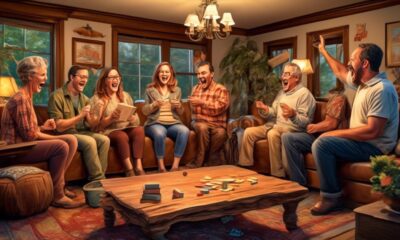
 Vetted4 weeks ago
Vetted4 weeks ago15 Best Group Games for Adults to Spice Up Your Next Gathering




















